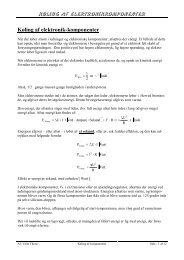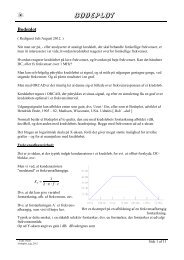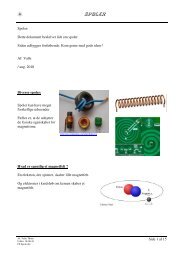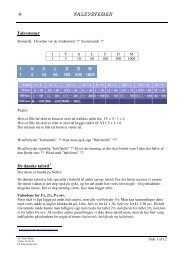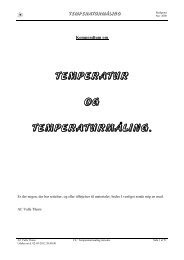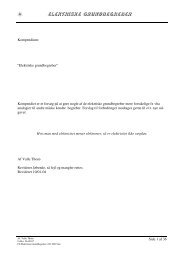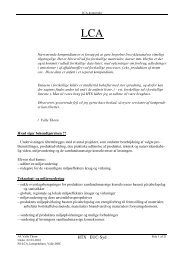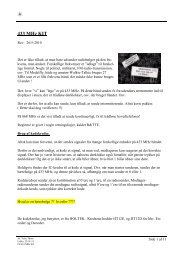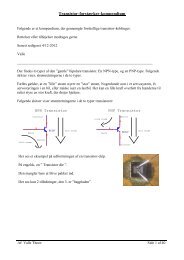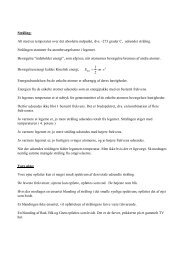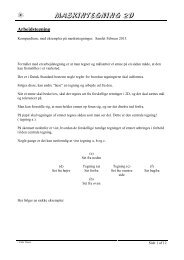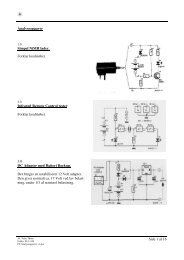Busser - Valle´s Bedste Hjemmeside.
Busser - Valle´s Bedste Hjemmeside.
Busser - Valle´s Bedste Hjemmeside.
Create successful ePaper yourself
Turn your PDF publications into a flip-book with our unique Google optimized e-Paper software.
<strong>Busser</strong><br />
The Serial Peripheral Interface Bus or SPI bus is a very loose standard for controlling<br />
almost any digital electronics that accepts a clocked serial stream of bits. A nearly identical<br />
standard called "Microwire" is a restricted subset of SPI.<br />
SPI is cheap, in that it does not take up much space on an integrated circuit, and effectively<br />
multiplies the pins, the expensive part of the IC. It can also be implemented in software with a<br />
few standard IO pins of a microcontroller.<br />
Many real digital systems have peripherals that need to exist, but need not be fast. The<br />
advantage of a serial bus is that it minimizes the number of conductors, pins, and the size of<br />
the package of an integrated circuit. This reduces the cost of making, assembling and testing<br />
the electronics.<br />
A serial peripheral bus is the most flexible choice when many different types of serial<br />
peripherals must be present, and there is a single controller. It operates in full duplex (sending<br />
and receiving at the same time), making it an excellent choice for some data transmission<br />
systems.<br />
In operation, there is a clock, a "data in", a "data out", and a "chip select" for each integrated<br />
circuit that is to be controlled. Almost any serial digital device can be controlled with this<br />
combination of signals.<br />
SPI signals are named as follows:<br />
SCLK - serial clock<br />
MISO - master input, slave output<br />
MOSI - master output, slave input<br />
CS - chip select (optional, usually inverted polarity)<br />
Most often, data goes into an SPI peripheral when the clock goes low, and comes out when the<br />
clock goes high. Usually, a peripheral is selected when chip select is low. Most devices have<br />
outputs that become high impedance (switched-off) when the device is not selected. This<br />
arrangement permits several devices to talk to a single input. Clock speeds range from several<br />
thousand clocks per second (usually for software-based implementations), to several million<br />
per second.<br />
Most SPI implementations clock data out of the device as data is clocked in. Some devices use<br />
that trait to implement an efficient, high-speed full-duplex data stream for applications such as<br />
digital audio, digital signal processing, or full-duplex telecommunications channels.<br />
On many devices, the "clocked-out" data is the data last used to program the device. Readback<br />
is a helpful built-in-self-test, often used for high-reliability systems such as avionics or<br />
medical systems.<br />
In practice, many devices have exceptions. Some read data as the clock goes up (leading<br />
edge), others read as it goes down (falling edge). Writing is almost always on clock movement<br />
that goes the opposite direction of reading. Some devices have two clocks, one to "capture" or<br />
"display" data, and another to clock it into the device. In practice, many of these "capture<br />
clocks" can be run from the chip select. Chip selects can be either selected high, or selected<br />
low. Many devices are designed to be daisy-chained into long chains of identical devices.<br />
SPI looks at first like a non-standard. However, many programmers that develop embedded<br />
systems have a software module somewhere in their past that drives such a bus from a few<br />
/: Valle Thorø<br />
Side 33 af 43



